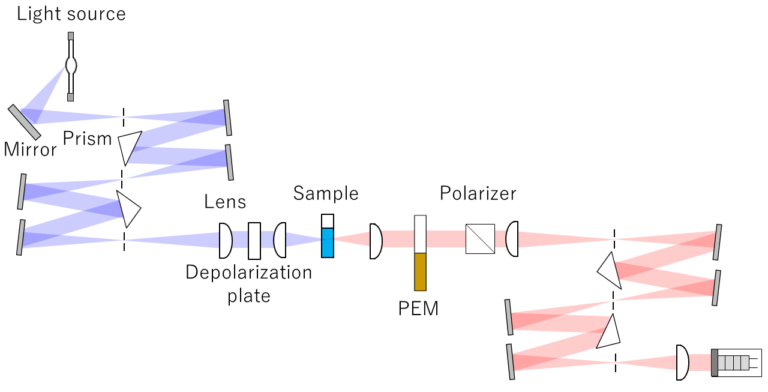
Circular dichroism (CD) spectroscopy is widely used in the study of optically active substances. In recent years, circularly polarized luminescence (CPL) spectroscopy has also attracted a great deal of attention. Whereas CD spectroscopy provides information about the structure of optically active substances in the ground electronic state, CPL spectroscopy provides information about excited states. The two methods are therefore complementary to each other.
Materials that exhibit circularly polarized luminescence are currently being actively investigated for applications in fields such as liquid crystal display backlights, three-dimensional (3D) displays, holographic displays, light sources for controlling plant growth, and security systems for optical communications and printing. It is therefore important to identify molecules that emit one-handed circularly polarized light (CPL) with a high quantum yield.
CPL spectra contain important information such as the stable structure of excited molecules, and the behavior of these molecules in chemical reactions that involve an intermediate excited state. Generally, fluorescence signals from a sample are weak and CPL signals are even weaker, making them difficult to detect.
The JASCO CPL-300 achieves high sensitivity for detecting such weak CPL signals and allows measurements to be performed over a wide wavelength range.
Light from a light source is first passed through a monochromator, and the sample is then irradiated by non-polarized light. The left- and right-handed circularly polarized fluorescence emitted by the sample is alternately linearly polarized at a frequency of 50 kHz using a PEM.
A polarizer is placed at the back of the PEM, and the polarized fluorescence is transmitted synchronously with the modulation of the PEM, and is passed through a monochromator and then detected by a detector.

©Jasco Europe S.R.L. (Socio Unico) Direzione e coordinamento ex. art. 2497 bis c.c. – P.I. 08609570158 | Privacy Policy | Cookie Policy | Manage consent | Realizzazione sito web: Alkimedia
| Cookie | Duration | Description |
|---|---|---|
| cookielawinfo-checbox-analytics | 11 months | This cookie is set by GDPR Cookie Consent plugin. The cookie is used to store the user consent for the cookies in the category "Analytics". |
| cookielawinfo-checkbox-necessary | 11 months | This cookie is set by GDPR Cookie Consent plugin. The cookies is used to store the user consent for the cookies in the category "Necessary". |
| CookieLawInfoConsent | 1 year | Records the default button state of the corresponding category & the status of CCPA. It works only in coordination with the primary cookie. |
| elementor | never | This cookie is used by the website's WordPress theme. It allows the website owner to implement or change the website's content in real-time. |
| viewed_cookie_policy | 11 months | The cookie is set by the GDPR Cookie Consent plugin and is used to store whether or not user has consented to the use of cookies. It does not store any personal data. |
| Cookie | Duration | Description |
|---|---|---|
| Google Maps | Google Maps is a map visualization service managed by Google Inc. and is used to integrate such contents within its pages. |